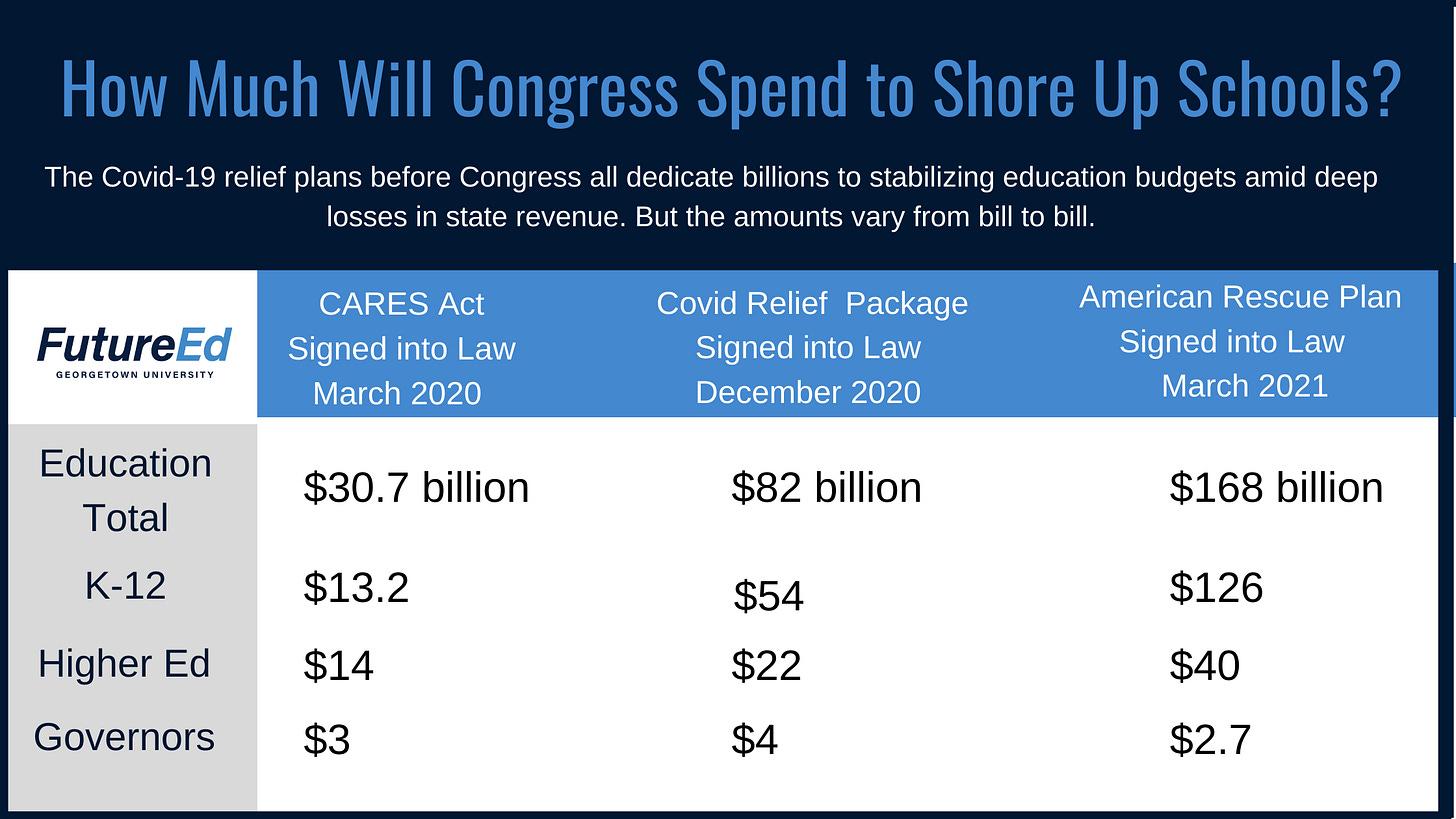What support districts need to plan for federal relief dollars
Curated U.S. Education Policy News for April 7, 2021
I think we can all agree that with fewer opportunities for physical convening this past year the education sector may have overcompensated with an explosion of content covering top news in education policy. As such, I am no longer going to create duplicative content of others like John Bailey’s COVID updates, the74 policy updates, and the Collaborative’s weekly round up. Instead, I’d like to pivot and use this space to ideate, expand, and refine emerging themes at the nexus of research, policy, and practice. Posts will occur more fluidly based on real-time policy trends, pragmatic questions arising from the field, and where there is a need for collective knowledge-making.
THE CHALLENGE
Yesterday, I had a conversation that is an iteration of many discussions I’ve witnessed this month: How are we going to spend and be accountable for the unprecedented federal relief funding coming our way to address the impacts of the pandemic?
Twenty-percent of the American Rescue Plan funds allocated to K12 school districts must address learning loss. This requirement has prompted common challenges for both rural, suburban, and urban school districts across the country, likely varying by the extent to which governance models are centralized or not (i.e. less capacity and foresight to make solid and intentional plans).
Mostly, school districts are working to safely reopen their doors and reify their services, keep them open through fluctuating community COVID case rates, and negotiate the daily tradeoffs necessary to rebuild trust with communities. With the Biden administration swiftly addressing many of the uncertainties we’ve experienced over the past year (e.g. vaccines and COVID-19 testing in schools), it is evident that centralized and strong executive leadership eases the workload on local education agencies.

THE EVIDENCE
In other words, it is critical that US education policy experts, researchers, and executive leaders pull together just-in-time roadmaps that state and district chiefs can adapt and expand upon. Many of these resources were released within the past month and can be used to formulate and implement evidence-based policies and pathways to support learning acceleration in the short- and long-term:
American Rescue Plan Act of 2021: Analysis of Funding for Education, Children, and Families | Bellwether
The Biden COVID stimulus: Big spending can bring big liabilities | CRPE
How Schools Should Use Funding from the American Rescue Plan to Support Students | Chiefs for Change
Recommended Uses for K-12 Learning Loss Funds | Education Reform Now
The Acceleration Imperative: A Plan to Address Elementary Students’ Unfinished Learning in the Wake of Covid-19 | Fordham Institute
Perspectives on How Schools Should Spend Covid Relief Aid | Future Ed
An Unparalleled Investment in U.S. Public Education: Analysis of the American Rescue Plan Act of 2021 | Learning Policy Institute
Moneyball for Education | Results for America
THE, “SO WHAT?”
Over the past month we’ve seen state and national efforts to establish infrastructure around using federal relief dollars to address learning acceleration en masse. Tennessee established a summer tutoring corps that will provide one-to-one tutoring services for the second year in a row. In Rhode Island, a partnership between the Department of Education and Khan Academy’s Schoolhouse.world will connect students with tutors from across the globe. We are also seeing national experts and federal leaders from USED provide explicit guidance (a very different tune than last spring). Check out this webinar with FutureEd, The Southern Regional Education Board, Education Trust, and USED leadership:
It is exciting to see these resources and plans unfolding for our students and families. However, we must be reviewing these investments and policies through the lens of implementation and outcomes, as well. I urge to ask more questions, like:
What are the theories of action underlying their design?
How are data and research being centered to answer the short- and long-term public-interest questions?
Where can we have the foresight to mitigate the funding inequities that we’ve seen play out for generations?
How will assessment data (or lack there of) play a role in these investment strategies and community conversations?
I welcome your commentary on this topic and opportunities to collaborate and discuss, please leave me a message with your thoughts.
Dr. Christine M. T. Pitts is a transformative and visionary education policy leader. As an Oregonian, raised by a multicultural family of educators, she brings over a decade of progressive strategic leadership experience and analytic skill to crafting state education policy. An educator and researcher by training, she has conducted legislation, governance, and policy analyses on a wide array of education issues using social network analysis and mixed methods research. In addition, Dr. Pitts is a facilitative leader who deeply understands and co-constructs local and national partnerships across stakeholder groups. Dr. Pitts currently coordinates between state and national policy leaders to investigate and advocate for policies that prioritize racial equity in education. Christine lives with her husband and four children in Portland, Oregon. Follow her on Twitter @cmtpitts.






